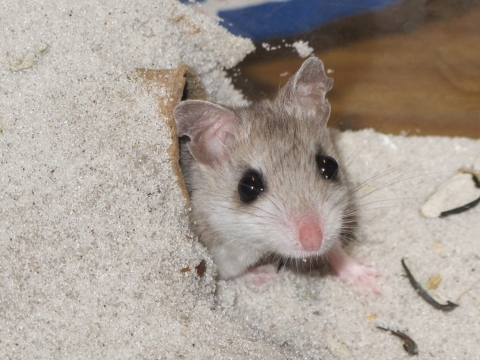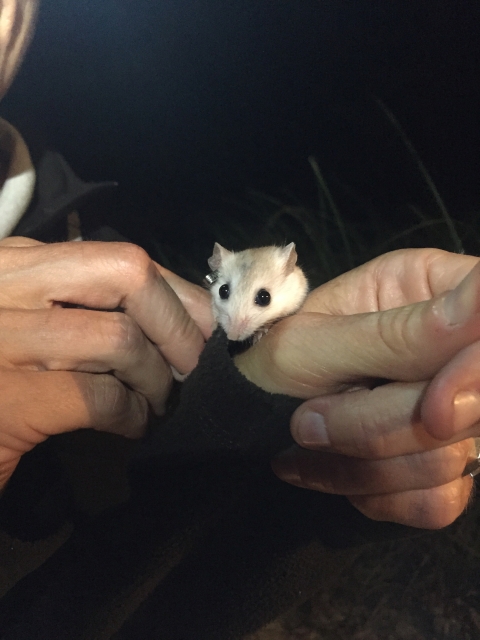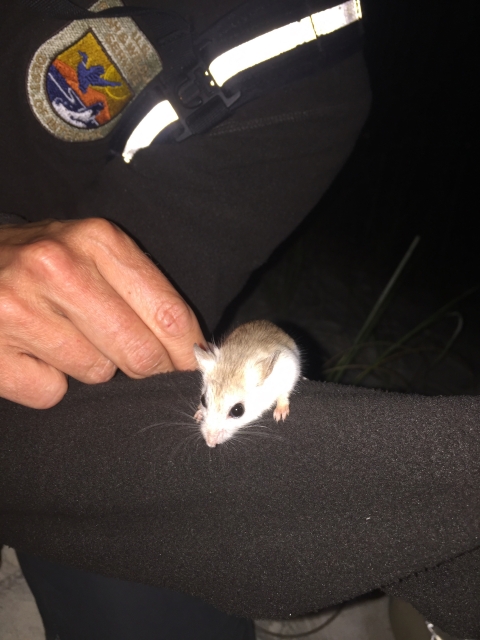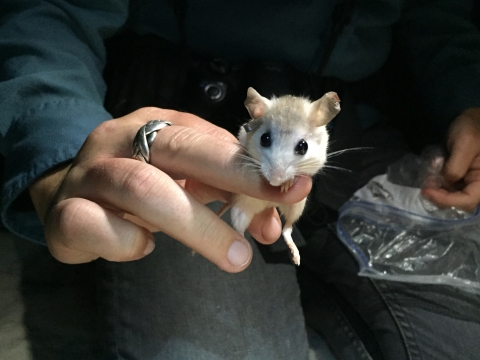Pensacola, Florida – Pity the big-eared, bug-eyed Perdido Key Beach mouse.
Buffeted by hurricanes, threatened by development, and stalked by cats, the thumb-sized mouse had all but disappeared from the sliver of beach outside this bustling Gulf Coast town. A decade ago, the U.S. Fish and Wildlife Service feared extinction.
Today?
“The mouse is doing pretty well right now,” said Kristi Yanchis, a Service biologist and beach mouse expert. “Their numbers have bounced back and their population is at the highest levels since they were first listed in 1985. But they still face significant threats to their long-term survival.”
Maybe 3,500 mice roam a 17-mile stretch of sand dune and sea oat along the barrier island shared by Florida and Alabama, though the rodent’s overall numbers rise and fall with the seasons. But recovery the Perdido Key mouse population – at least until the next major hurricane – hasn’t been easy, cheap or universally applauded.
Single-home builders bristled at new regulations intended to boost mouse habitat. Developers decried a permitting process that threatened to take years. A conservation group sued.
“My initial reaction was shock,” said Greg Jones, a senior project manager for Perdido Key’s largest residential development. “We had all our permits intact and [then] we had to jump through a lot of hoops. There was a pretty lengthy period where we all had to educate each other about what we were doing. It was definitely something greatly different than what we expected.”
The frustrations and delays, though, came with a silver lining. The mouse’s endangered species status prompted Escambia County to craft a habitat conservation plan that guides development. In essence, the Endangered Species Act (ESA) was used by the local community as a land-use tool to guide development and manage traffic.
“The endangered species issues have done a good job helping to maintain the vision of Perdido Key as a village which isn’t overbuilt or a condo canyon,” said Tim Day, natural resource manager for Escambia. “The island’s habitat has to be as nice as the condo you’ve just constructed.”
Destined to lose?
Perdido Key Beach mice, like you and me, love the beach. And that’s the problem. Their homes occupy the same coveted barrier island that draws droves of vacationers, retirees and second-home buyers. In the never-ending development-versus-conservation tussle, the mouse seemed destined to lose.
“Alteration and destruction of habitat for recreational, commercial and residential development has been a major factor in the decline of beach mice,” the Fish and Wildlife Service wrote in its 1987 recovery plan for the mouse.
The Service, along with local, state and other federal agencies, has worked 30 years to save the mouse. Success, one day, means self-sustaining populations of the rodent at Perdido Key State Park and Gulf Islands National Seashore, both in Florida, and Gulf State Park in Alabama, and ways for the mice to amble between the parks.
The recovery plan listed a slew of objectives to protect the mouse’s critical habitat: rebuild, and curb, public access to the dunes; add boardwalks; plant dune- and mouse-sustaining vegetation; keep cats, foxes and other predators at bay; institute a captive-breeding program.
Recovery efforts appeared to be working. In early 2004, biologists estimated that 500-800 mice called Perdido Key home. Then Hurricane Ivan, with winds of 120 mph and 12-foot storm surges, hit in September obliterating much of the mouse’s dune habitat.
A year later, after another brutal hurricane season, few mice were found. Another survey, in March 2007, turned up only one (dead) mouse at Perdido Key State Park.
The Great Recession couldn’t have come at a better time for the mouse’s sake. Virtually all development came to a halt. Escambia County crafted its habitat conservation plan (HCP) dictating the placement of homes, shops, parking lots and more.
“When we first started, my commissioners didn’t have any interest in working with the feds,” Day said. “But we had time to work through the HCP without real intense pressures from developers [anxious] to get something built. We got lucky on the timing.”
The plan identified actions builders and homeowners must take to keep from killing mice. In return, they’d receive a hopefully hassle-free path to permitting and construction.
Eight years later, county commissioners and the Service decided that development would be allowed on 66 acres of the island over 30 years. Mitigation fees paid to the county cost $100,000 per acre and support the mouse and its habitat. Homeowners pay annual impact fees of $201.
Buildings must be clustered together to minimize sprawl and create more space for mice. Palm trees are frowned upon; native vegetation is required. Property owners must install wildlife friendly lights to keep predators from espying the nocturnal beach mice. Outdoor cats are not allowed.
“People hated the new regulations at first, but they got used to them and realize they’re a cost of doing business,” said Yanchis. “They can still build their house and have their piece of heaven. They just have to be willing to live with an endangered species. Newcomers who realize that upfront seem to embrace the new rules.”
Why did the beach mouse cross the road?
Yanchis pulled into a seemingly typical construction site on the beachside of Fla. 292, Perdido Key’s main drag. Upon closer inspection, though, the two homes – built for a brother and sister from Alabama – differed from the usual stucco-pastel-palm tree layout favored by most beach builders.
The driveway was narrow and permeable to allow rainwater to seep into the ground. Outside lights were recessed into the eaves and targeted straight down. Mounds of sand were strategically placed to resemble dunes. Sea oats, yaupon holly and scrub pines surrounded the homes.
Perdido Key State Park straddles 292. Four mice-friendly culverts were built by the Florida Department of Transportation to allow mice to cross the road. Road crews worked during the day to avoid hassling the night-loving mice.
The Service and its partners were also busy propagating the hairy-tailed critters in captivity. Forty-eight mice bred at zoos in Gainesville and West Palm Beach were released at Gulf State Park in spring 2010. (Fifteen were found dead a few days later in a red fox den.)
In September of that year, 51 mice were tallied and, for the first time since they were listed in 1985, located in all three parks.
But with the recession’s end, and home-building kicking into gear, Yanchis and others say privately owned property is the focus. No project loomed larger than the Lost Key Golf and Beach Club, a 413-acre condo and townhome community along 292.
A decade ago the key’s largest residential project sought federal permission, including a wetlands fill-in permit from the U.S. Army Corps of Engineers, to build 1,900 residences. Fish and Wildlife determined that 59 acres were beach mouse habitat and, after much negotiation, agreed that 26 acres could be built on.
Defenders of Wildlife, a conservation nonprofit, sued the Service and the Corps in January 2014 alleging the permit violated the ESA by harming mouse habitat.
The Service went back to the Corps and the developer who ultimately agreed to add native plants, dry retention ponds, better lighting and curb cuts (so mice and other animals could more readily access suitable habitat). WCI Communities also clustered homes closer together, which conserved more land, rerouted roads and dropped a beachside parking lot. The company also contributed $1.9 million to conserve habitat.
Lost Key got federal permission to build. It now plans less than 1,000 residences; about 100 are under construction or built.
“There was a lot of give-and-take by all parties to really find the proper balance,” said Greg Jones, a senior project manager with WCI which is part of the Lennar homebuilding corporation. “But we greatly lowered the impacts on our property. And now you truly feel like you’re in a nature preserve.”
Other condo projects are on the books. Single-family homes too are being built. Neither the county or federal mouse habitat rules have crimped development. In fact, the City of Orange Beach, down 292 into Alabama, is considering a habitat conservation plan modeled on Escambia County’s.
The tiny mouse that roared, thankful for all who rallied to his side, is being heard loud and clear.
“It now appears that we are heading towards recovery,” Yanchis said. “But it’ll probably take another hurricane to see if the mouse can bounce back with from the safeguards we are putting in place.”







